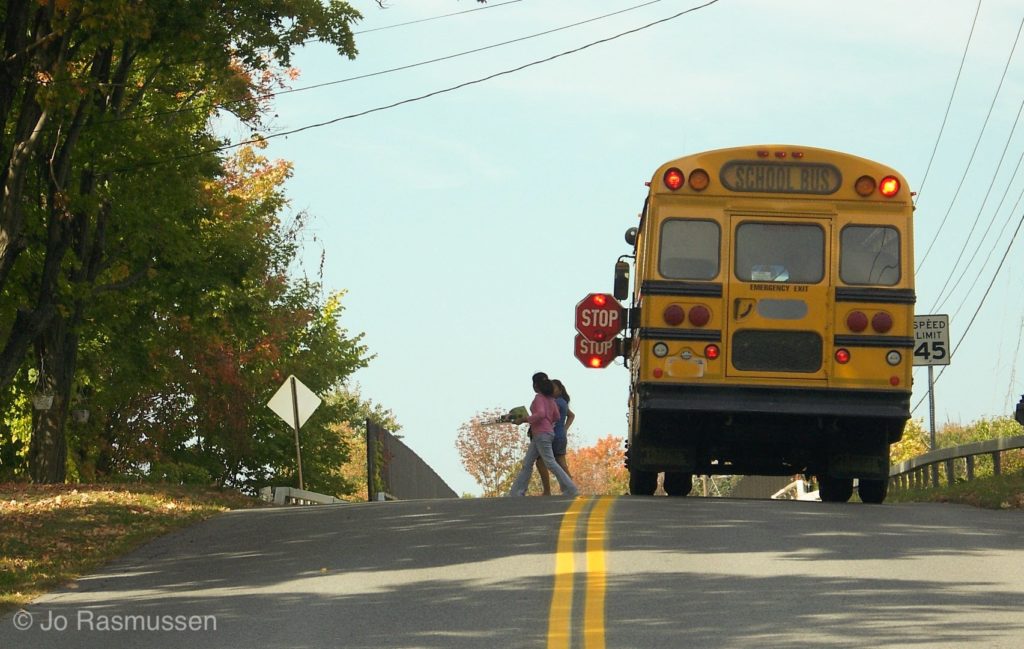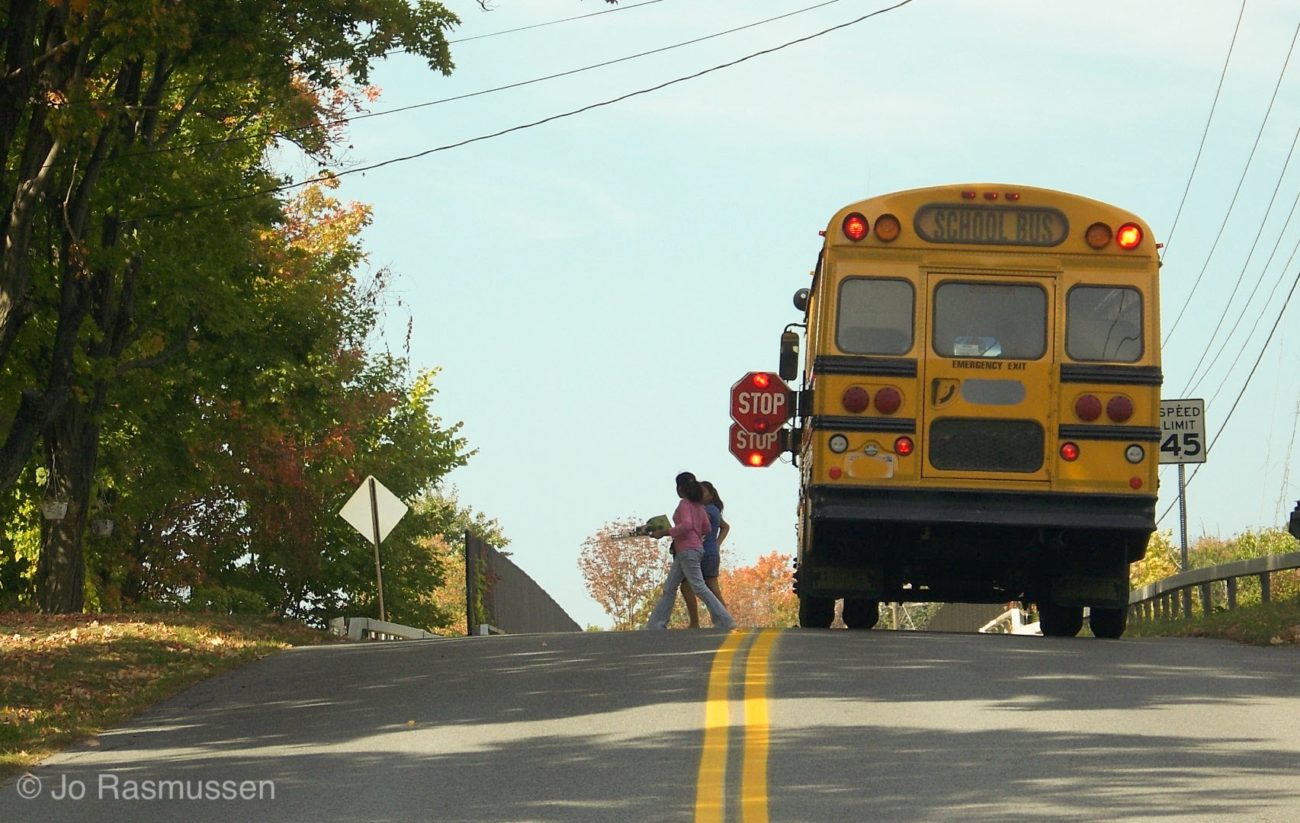Yes, school is open and our school buses are on the move…

How can we keep our children safe?
Nationwide, statistics show October is the most dangerous time for our young ones? October is the month that has the greatest potential for fatalities of our children in relation to our most beloved icon, the yellow school bus.
School buses on the move –
Some things you need to know:
- Our youngest are at risk. Typically the riskiest age for school children is age 5 – 7. Why might this be? Well, they’re still tenderly young… they haven’t had much experience in life, let along experience with school bus safety. Additionally, children in this age group have short attention spans and are impulsive. This can be very challenging!
- The most common cause of fatalities in school bus world has historically been “by your own bus”. Just the thought brings chills up my spine. Passing motorists is the second most common cause of child fatalities at the bus stop.
- Both boys and girls are equally vulnerable.
- The weather conditions are generally clear and the roads are dry.
- Most fatalities occur as the child is boarding or getting off the bus. However, getting off in the afternoon is most dangerous… Why? It’s the end of the day. Everyone is tired. Are the littles anxious to go home and see mommy or daddy? Could the driver also be anxious (and somewhat distracted) – to finish the day’s work and go home. School bus drivers human, too…!
So, what can parents or caregivers do to help these little ones be safe?
What can a school bus driver do?
I can personally speak for both sides – I am a parent, I am a grandparent, I am a school bus driver, AND I am a trained school bus driver instructor in New York State.
However, I would like to address (first) what the school bus driver can do to help prevent a tragedy.
School buses are on the move –
Important safety reminders for the school bus driver…
These recommendations are for the afternoon run. The morning run will be addressed in another post.
- APPROACH: When approaching a bus stop, engage your amber lights (part of the 8-way light system) at least 300′ before the designated stop. Approach slowly. Stop your bus no further than 18″ away from the curb. Be aware of the traffic behind you and approaching you. Try to determine whether or not they see you! (It’s a sunny afternoon – they may also be tired and distracted!)
- STOP THE BUS: Train your students to stay seated until the bus comes to a complete stop.
- SECURE THE BUS: If you drive a large bus with air brakes, set your brake and place the transmission in neutral. If you drive a smaller school bus, place the transmission in park. In both types of vehicles, keep your foot on your brake. This lets vehicles behind you know that you are stopped.
- OPEN THE DOOR: Before opening the door to release your students, be sure all traffic is stopped. By opening your door (remember to turn on your Master switch) and activating your “reds”, you are communicating to other drivers that you are releasing students from your bus and that they need to stop and wait until your red lights go off. ***HOWEVER, don’t count on everything going as planned… vehicles go through our reds, vehicles approaching from the rear go around our vehicles on the right, parents, dogs, siblings all add to the confusion at the bus stop.
- DISTRACTION: Avoid distraction at all costs – especially on a sunny, clear (and dry!) day in the afternoon. Keep your mind in “bus driver world”. The kids are noisy, excited to get home. Traffic at this time is usually over-the-top: parents rushing to get home, young drivers rushing to their after-school jobs, other buses trying to get their precious cargo to their destinations. On top of everything else, you want to get home, it’s been a long day – you, too, are tired. You can also train your riders to quiet down – flash your dome lights to let them know it’s time to be quiet!
- FOCUS on the unloading procedure. This is no time to try settling any problems that may be brewing on the bus. This is no time to answer questions from your little ones (“Bus driver, can I have a tissue?”) Keep your focus on this most crucial step to keep your disembarking riders safe…
- INSTRUCT YOUR STUDENTS what you expect them to do. Train your students to “stop, look, and listen!” The first step is teaching them to “Check before you step” off the bus… What this means is for the students to look both ways before stepping off the bus to the ground. If a vehicle is passing the bus on the shoulder, this checking both ways could safe their life! The second step: instruct your crossing students to walk up the shoulder towards the front of the bus at least 10 steps (more if small) to a place on the shoulder when the student can make eye contact with you. We call this: “I see you. You see me!” It is important for every student to look at you (do not allow the one student to be gazing down at his cellphone relying on the movement of other crossers). When (from your viewpoint) you feel it is safe for them to start crossing, giving the safe-crossing signal. Teach your students to stop midway to check for traffic (a second “check before you step” – into an unprotected traffic lane)… then they can proceed across. Teach your Non-crossers to move away from the bus in the driveway and wait for you to leave the area before they go check the mailbox, walk (down the street) to their home, etc.
- BEFORE MOVING THE BUS: Stay focused! Check to make sure all students are completely away from your bus. If possible, count your students before they get off – and make sure all the students are where they should be! Check your mirrors (especially pay attention to your tires both rear and front), check the front bumper, check the door! At this point you should (foot still be on the brake) place your transmission in “drive”, and/or release your air brake. THEN – check your mirrors (again) AND “Check the Door – Once More!!”
- PULL AWAY FROM THE BUS STOP VERY SLOWLY
School buses are on the move –
Important safety reminders for parents and caregivers to keep children safe at the bus stop in the afternoon…
- Wait for your child at the bus stop prior to the buses’ arriving.
- If you bring a pet to the bus stop, please keep the pet leashed. This prevents your pet from running in front of the bus or another vehicle or a child getting bit. Remember – some children are just plain terrified of dogs!
- If you bring siblings or other children with you to the bus stop, it’s important to keep track of these little ones. In all their excitement of seeing the school bus and their brother or sister, they may wander in front of the bus or out in traffic resulting in a tragedy.
- If your child is one who must cross the road, you learn the “safe crossing signal” from your child’s bus driver and cooperate with the driver – never interfere with this safety procedure. Your child needs to learn to cross the road safely with the help of the school bus driver – after all, there may be a day when you are not there to meet the bus… and your child needs to know and follow this important safety procedure!
In Conclusion…
So – beware of October. School’s in session and school buses are on the move! And October is a month that especially speaks of caution at the bus stop.
And may you and your family have a wonderful, safe incident free school year – especially on the school bus and at the school bus stop!
